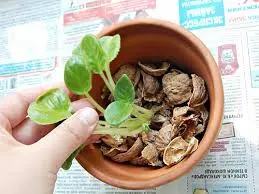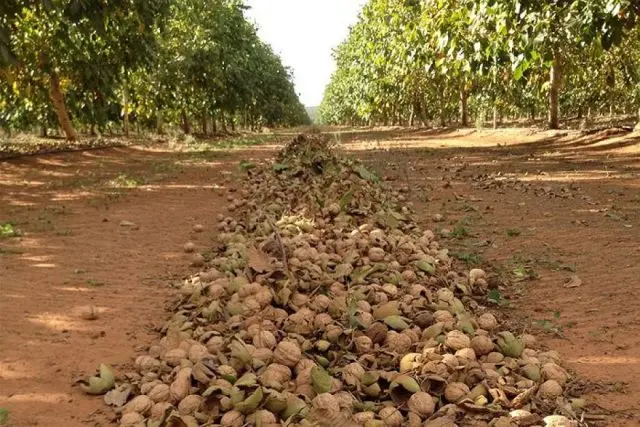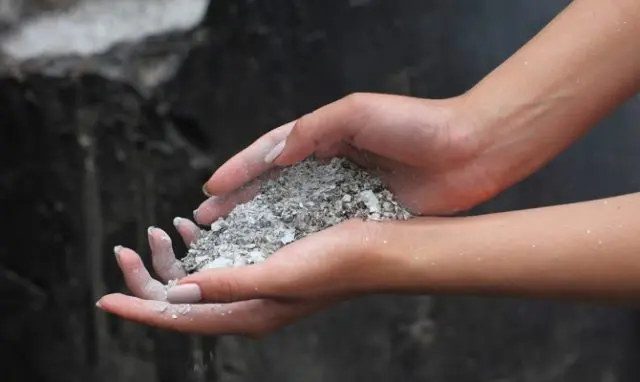Contents
Even despite the fact that the walnut belongs to purely southern plants, its fruits have long been very popular in Our Country. Their use is known both in cooking and for medicinal purposes. The people’s love did not bypass the attention of the nut shell. The outer shell was used primarily for the manufacture of various tinctures and decoctions. But the use of walnut shells in the garden deserves no less attention, especially in those regions where a significant harvest of these fruits can be harvested.

Useful properties of walnut shell
Many do not recognize at all any benefit from the use of the shell of this nut and believe that the easiest way is to just throw it in the trash can. Owners of their own house with stove heating, or at least with a bathhouse on the site, still recognize the possibility of using it as a good kindling. Indeed, the shell burns well, while releasing quite a lot of heat.
More advanced gardeners consider it appropriate to use the ash obtained from the burning of the shell for the garden and other household needs. But this is not the end of its scope. You just need to take a closer look at its composition in order to understand that the peel can be used not only in the garden, but also when growing plants at home.
So, what is the composition of the walnut shell:
- like many plants, it is more than 60% fiber;
- extractive-type substances also occupy a solid volume in its composition – more than 35%;
- proteins make up 2,5% of its volume, and fats – 0,8%;
- about 2% is occupied by ash compounds;
But, besides this, the composition of the peel includes:
- amino acids;
- steroids and alkaloids;
- organic, including phenolcarboxylic acids;
- coumarins;
- proteins;
- vitamins and microelements;
- tannins.
Many of these substances, to one degree or another, affect the growth processes that occur with plants. Some of them in small quantities serve as growth stimulants, especially the development of the root system. With an increase in the concentration used, they can also serve as inhibitors of growth and development.
Tannins and some other substances can serve to restore damaged tissues in plants and are able to fight many harmful microorganisms.
Using walnut shells in the garden
In those areas where walnuts are grown commercially (from a few trees on the site), it is best to use its shell in the garden in the form of drainage. In lowered areas of the site, where stagnant water often occurs, pour out and evenly distribute several bags of shells. You can also use walnut shells to create a drainage layer when planting seedlings of ornamental and fruit crops, as well as to create high beds in the garden.
But the peel of the nut can come in handy as a drain and in small quantities when growing seedlings or houseplants. To do this, when transplanting, the bottom of each flower pot or container is covered with a layer of shell from 2 to 5 cm high, depending on the size of the container itself. From above, the container is filled with soil to a depth not less than the height of the drainage layer.

This is done so that excess moisture does not stagnate in the recesses of the shell.
In the presence of large volumes of walnut shells, it is actively used as a mulching material in the garden and in the garden. That is, to maintain optimal soil moisture, so that you do not need to water the plants once again. Under trees and shrubs, you can use either halves of the shell, or pieces, about 1,5-2 cm in size. For mulching flower beds and beds in the garden, the shell is crushed with a hammer to a finer fraction. The optimal size of the pieces should not exceed 0,5 cm. In order for the mulch to perform not only a moisture-retaining function, but also protect against weeds, it is necessary to make a layer thickness of at least 4,5-5 cm.
And the largest pieces of the shell can be used to create or decorate paths in the garden or vegetable garden. In this case, the layer thickness should already be much larger – from 10 cm or even more. But even in this case, shell pieces can eventually go into the ground, especially with good compaction. To prevent this from happening, it is advisable to initially remove the turf in place of future tracks and cover the entire surface with dense black material. A layer of prepared walnut shells is already placed on it. At the very end of the work, the pedestrian zone should be compacted as much as possible.

The most popular way to use walnut shells in the garden is to add it to the soil as a fertilizer or soil conditioner. True, in this case it is necessary to grind the shell to an almost powder state with a piece size of no more than 1-2 mm.
But there are several problems here:
- Firstly, grinding the shell to such a fine state is a rather laborious operation, and not all gardeners are ready to go for it.
- Secondly, many gardeners are afraid of the adverse effect of the nut shell on the plants in the garden due to the content of the natural antibiotic juglone in the fruits.
But juglone is found predominantly in the roots, bark, leaves, and green skins of walnuts. As the fruit ripens, its concentration in the shell decreases sharply. In addition, there is the most optimal way to cope with both problems – burn the nut peel, and use the resulting ash as fertilizer in the garden. As a result, you do not have to perform time-consuming actions to crush the shell, and all substances that are unsafe for plants disappear.
The very same ash from the burning of walnut shells contains at least 6-7% calcium, about 20% potassium, 5% phosphorus, and, in addition, a diverse amount of trace elements presented in the most assimilable form for plants: magnesium, iron, zinc, sulfur and others.
The use of ash from burning the peel is possible in two ways: simply mixing it with the soil or using it dissolved in warm water for watering or spraying plants.
The main thing to remember is that the walnut shell is saturated with a large amount of biologically active substances. Therefore, it should be used with caution. You can try to start with small doses, if the effect is only positive, then you should expand the scope of its application in the garden.
Tips from experienced gardeners
Experienced gardeners are advised to approach the use of walnut shells in a complex manner. Grind, as far as possible, a small amount of it and add it to the soil for growing seedlings of tomatoes and peppers to improve the mechanical composition.
Larger particles are great for planting mature tomato seedlings and for laying cucumber beds in the garden as drainage.
If there are still concerns about using the shell fresh for the garden, it can be placed on the compost heap and any negative impact on the microbiological composition of the soil can be avoided.
Many fans of organic farming try to form high or warm ridges, even unground peel is also ideal as a filler for their lower layer.
Some growers use crushed shells to sprinkle potted soil to keep it loose and not crusty from hard watering.

Ash obtained by burning walnut peel is an ideal fertilizer for almost all types of garden crops and flowers. Just use it in moderation. Because its composition is more concentrated than that of ordinary wood ash.
Conclusion
The use of walnut shells in the garden is very diverse. If desired, even a small amount of it can be used for the benefit of plants or seedlings. And those who are lucky enough to grow walnuts on their plots can afford to dispose of this product for the benefit of both plants and the garden itself.









